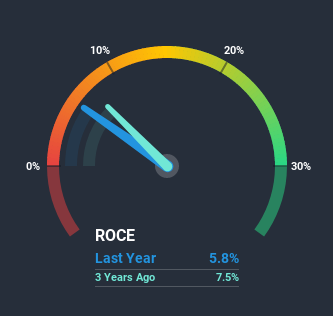
If we want to find a potential multi-bagger, often there are underlying trends that can provide clues. One common approach is to try and find a company with returns on capital employed (ROCE) that are increasing, in conjunction with a growing amount of capital employed. This shows us that it's a compounding machine, able to continually reinvest its earnings back into the business and generate higher returns. So when we looked at Bhagyanagar India (NSE:BHAGYANGR) and its trend of ROCE, we really liked what we saw.
What is Return On Capital Employed (ROCE)?
For those who don't know, ROCE is a measure of a company's yearly pre-tax profit (its return), relative to the capital employed in the business. The formula for this calculation on Bhagyanagar India is:
Return on Capital Employed = Earnings Before Interest and Tax (EBIT) ÷ (Total Assets - Current Liabilities)
0.058 = ₹80m ÷ (₹2.3b - ₹965m) (Based on the trailing twelve months to September 2020).
Thus, Bhagyanagar India has an ROCE of 5.8%. Ultimately, that's a low return and it under-performs the Electrical industry average of 10%.
View our latest analysis for Bhagyanagar India

Historical performance is a great place to start when researching a stock so above you can see the gauge for Bhagyanagar India's ROCE against it's prior returns. If you want to delve into the historical earnings, revenue and cash flow of Bhagyanagar India, check out these free graphs here.
What Can We Tell From Bhagyanagar India's ROCE Trend?
Bhagyanagar India has not disappointed in regards to ROCE growth. We found that the returns on capital employed over the last five years have risen by 130%. That's not bad because this tells for every dollar invested (capital employed), the company is increasing the amount earned from that dollar. Interestingly, the business may be becoming more efficient because it's applying 52% less capital than it was five years ago. If this trend continues, the business might be getting more efficient but it's shrinking in terms of total assets.
For the record though, there was a noticeable increase in the company's current liabilities over the period, so we would attribute some of the ROCE growth to that. Effectively this means that suppliers or short-term creditors are now funding 41% of the business, which is more than it was five years ago. Given it's pretty high ratio, we'd remind investors that having current liabilities at those levels can bring about some risks in certain businesses.
The Bottom Line On Bhagyanagar India's ROCE
In summary, it's great to see that Bhagyanagar India has been able to turn things around and earn higher returns on lower amounts of capital. Considering the stock has delivered 6.4% to its stockholders over the last five years, it may be fair to think that investors aren't fully aware of the promising trends yet. So exploring more about this stock could uncover a good opportunity, if the valuation and other metrics stack up.
Bhagyanagar India does have some risks, we noticed 7 warning signs (and 2 which are significant) we think you should know about.
While Bhagyanagar India may not currently earn the highest returns, we've compiled a list of companies that currently earn more than 25% return on equity. Check out this free list here.
If you decide to trade Bhagyanagar India, use the lowest-cost* platform that is rated #1 Overall by Barron’s, Interactive Brokers. Trade stocks, options, futures, forex, bonds and funds on 135 markets, all from a single integrated account. Promoted
Valuation is complex, but we're here to simplify it.
Discover if Bhagyanagar India might be undervalued or overvalued with our detailed analysis, featuring fair value estimates, potential risks, dividends, insider trades, and its financial condition.
Access Free AnalysisThis article by Simply Wall St is general in nature. It does not constitute a recommendation to buy or sell any stock, and does not take account of your objectives, or your financial situation. We aim to bring you long-term focused analysis driven by fundamental data. Note that our analysis may not factor in the latest price-sensitive company announcements or qualitative material. Simply Wall St has no position in any stocks mentioned.
*Interactive Brokers Rated Lowest Cost Broker by StockBrokers.com Annual Online Review 2020
Have feedback on this article? Concerned about the content? Get in touch with us directly. Alternatively, email editorial-team (at) simplywallst.com.
About NSEI:BHAGYANGR
Slight and slightly overvalued.
Similar Companies
Market Insights
Community Narratives




